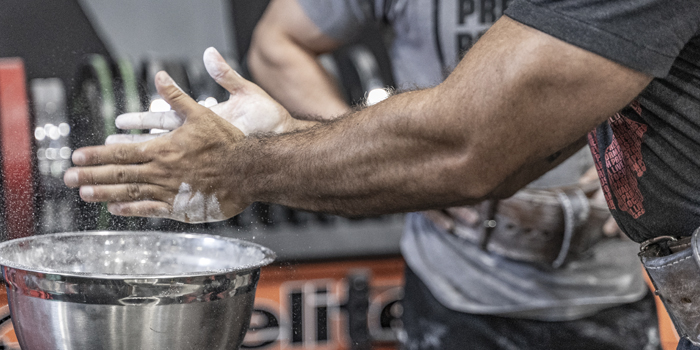
Looking for a program to help you gain weight and build strength at the same time? Making small changes to a program that has been around for decades can help you do just that.
German Volume Training (GVT) has been around since the 1970s and has been used by weightlifting coaches, bodybuilders, and athletes. I'm not trying to re-invent the wheel here but instead, put my spin on GVT.
The issue with most classic hypertrophy work is that the volume is too high. Super high volume makes it difficult to increase the intensity enough to build outstanding strength. By keeping the reps to five on the main movement, you can stay within a higher percentage of your one-rep max and specifically build your strength.
Modified GVT 10x5 Program
You are still completing the same amount of reps as you would with a 5x10 program, but the overall tonnage is increased. A traditional 5x10 program will require you to use approximately 50% of your one-rep max. For example, a person that squats 400 pounds for their one-rep max and is completing their program based on their 50% one-rep max will lift a total of 10,000 pounds. In comparison, the modified GVT 10x5 program allows you to lift at 70% of your one-rep max, increasing the total weight lifted to 14,000 pounds. As you can see, decreasing the reps in a set allows you to lift at a higher percentage of your one-rep max, thus increasing the total volume lifted.
An experienced lifter with solid training experience should be able to safely run their main lift at 70-75% of their one-rep max. If using this training technique with athletes with limited lifting experience or weakness in certain areas, starting between 50-65% of their one-rep max is beneficial. Start on the lighter side if you are unsure, and if the lift feels easy by the seventh set, increase the weight.
The lifter must complete all ten sets to benefit from this training program. Increasing the weight in small increments of five to ten pounds ensures that they can complete the full ten sets of five reps. It is not beneficial in this program if the weight is so heavy that the lifter can only complete seven to eight sets.
When completing accessory exercises, I prefer to stick to single-joint exercises and complete ten sets of ten reps with a 30-second rest. If you choose to do multi-joint exercises, complete them at three to four sets of ten reps and a 30-second rest. As with most programs, accessory exercises are used to improve strength in specific areas.
Diet + Rest + Recovery
To achieve the most benefit from this program model, ensure you are in a caloric surplus and getting enough rest. Even though only three exercises are being performed each day, your central nervous system is going to be FRIED, and your muscles are going to be SORE.
I have personally found this training method useful as a build-up into a true strength program or in preparation for a powerlifting meet. This program is beneficial to use during a small time window before a strength phase when training athletes. I have run this model many times with wrestlers coming off of a competitive season when they need to gain back lean muscle mass they have lost during the season.
In my experience, using a three- and four-day split model are both effective. Below are examples of what a three- and four-day split model looks like:
3-Day Split Model
- Day 1 Squat
- Day 2 Bench
- Day 3 Deadlift
Key Factors
- Keep the rest periods to 1 minute on the main movement and 30 seconds on the accessories
- Do not increase the weight until after set 7 (this is usually when you hit the wall)
- Maintain 48 hours between training days
4-Day Split Model
- Day 1 Bench
- Day 2 Squat
- Day 3 Bench
- Day 4 Deadlift
3-Day Split Model Sample
Day 1
- Bench Variation: 10 sets of 5 reps w/ 1 minute rest
Examples: Close Grip, Floor Press, Board Press, Pause Press, Incline Press
- 2-3 accessories: 10 sets of 10 reps w/ 30 second rest
OR
- 2-3 accessories: 3-4 sets of 10 reps w/ 30 second rest
Examples: Lat Pulldowns, Rows, Triceps Pressdowns, Face Pulls, JM Press, Tate Presses
Day 2
- Squat Variation: 10 sets of 5 reps w/ 1 minute rest
Examples: Competition Squat, High bar, Box squat, SSB Squat
- 2-3 accessories: 10 sets of 10 reps w/ 30 second rest
OR
- 2-3 accessories: 3-4 sets of 10 reps w/ 30 second rest
Examples: Hamstring Curls, Leg Extensions, Glute Ham Pulls, Pull Throughs
Day 3
- Deadlift Variation: 10 sets of 5 reps w/ 1 minute rest
Examples: Competition Stance, Non-Competition Stance, Deficits, Block Pulls
- 2-3 accessories: 10 sets of 10 reps w/ 30 second rest
OR
- 2-3 accessories: 3-4 sets of 10 reps w/ 30 second rest
Examples: Hamstring curls, RDL's, Leg Extensions, Back Extensions, Shrugs, Face Pulls
4-Day Split Model Sample
Day 1
- Bench Variation: 10 sets of 5 reps w/ 1 minute rest
Examples: Close Grip, Floor Press, Board press, Pause press, Incline Press
- 2-3 accessories: 10 sets of 10 reps w/ 30 second rest
OR
- 2-3 accessories: 3-4 sets of 10 reps w/ 30 second rest
Examples: Lat Pulldowns, Rows, Triceps Pressdowns, Face Pulls, JM Press, Tate Presses
Day 2
- Squat Variation: 10 sets of 5 reps w/ 1 minute rest
Examples: Competition Squat, High bar, Box Squat, SSB Squat
- 2-3 accessories: 10 sets of 10 reps w/ 30 second rest
OR
- 2-3 accessories: 3-4 sets of 10 reps w/ 30 second rest
Examples: Hamstring Curls, Leg Extensions, Glute Ham Pulls, Pull Throughs
Day 3
- DB Bench Variation: 10 sets of 10 reps w/ 1 minute rest
- 2-3 accessories: 10 sets of 10 reps w/ 30 second rest
OR
- 2-3 accessories: 3-4 sets of 10 reps w/ 30 second rest
Examples: Lat pulldowns, Rows, Tricep pressdowns, Face Pulls, JM Press, Tate Presses
Day 4
- Deadlift Variation: 10 sets of 5 reps w/ 1 minute rest
Examples: Competition Stance, Non-Competition Stance, Deficits, Block Pulls
- 2-3 accessories: 10 sets of 10 reps w/ 30 second rest
OR
- 2-3 accessories: 3-4 sets of 10 reps w/ 30 second rest
Examples: Hamstring Curls, RDL's, Leg Extensions, Back Extensions, Shrugs, Face Pulls
Travis Roberson is a high school strength and conditioning coach and owner of T7 Performance. Before working at the high school level, he was a Minor League Strength and Conditioning Coach for the Cleveland Guardians. Travis so was also a Strength Coach at the collegiate level for 6 years while competing in powerlifting.











Make my training better thank ?